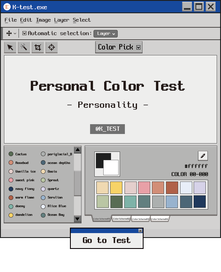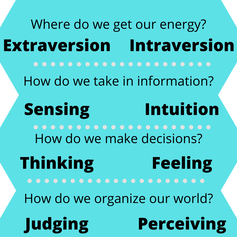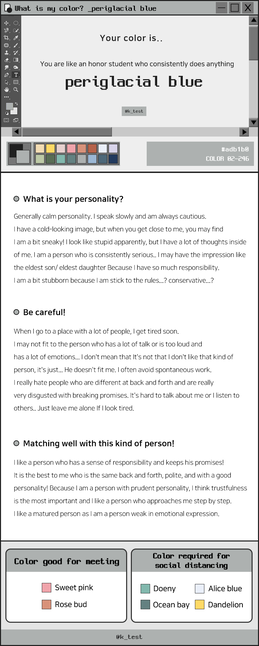What is the Personality Color Test? It seems like every public speaker, life coach, and school has their own form of assessments and personality tests. There’s good reasons for it. These tests allow you to get a better understanding of who you are and what your tendencies are. People can find out everything from their deepest motivations to which Harry Potter character best fits them. One recent addition to the personality test world is K Test One’s Personal Color Test. Here's my review of the test, what it is, how it works, and why it might actually be worth trying. What Color is my Personality?This personality test is a set of 12 questions created by a group out of Korea. The questions are a rough translation from the original Korean to English and ask questions like “What am I to my first-time friends?” and “What do I do when working?” All of this leads to your personality color and what that means for you. After completing all 12 questions, you are given a color. I did a little searching around these colors, especially with their recent popularity in Tik-Tok videos. There are 16 different color possibilities with some unique names. As someone who has used a variety of assessments and personality tests with students and clients, the 16 types sounded familiar, as did the questions they used along the way. On closer inspection, there were 4 separate themes in the 12 questions.
If you read that list and thought those categories were familiar, you are absolutely right. These are the four dichotomies or areas found in the Myers-Briggs Type Indicator (MBTI)
The Myers-Briggs Type Indicator The MBTI has been around for decades and is one of the most well-known and respected of the personality tests. It is backed by sound research and consistent results that trace their roots to psychologist Karl Jung’s personality theories. The MBTI has over 90 questions all analyzing preferences of how individuals take in and process information as well as interact with the world. There is constant debate over the validity of the MBTI and whether or not it is a useful test. However, when compared to many similar tests, the MBTI has a strong record for its consistency and breadth of use. The MBTI measures if you have a preference for a certain aspect of the 4 dichotomies as well as how much of a preference you have. You may have a noticeable preference for extraversion but have a slight preference to sensing depending on how you answer the questions. The personality color test does not dive into the amount of preference and it’s 12 simple questions do not dive as deeply into these dichotomies. Like many others, this assessment is just a fun test for the sake of adding some conversation points into a relationship. Personality Color and the MBTIIt is no surprise, then, that the popularized Personality Color Test is based off of the MBTI. In fact, if you choose to save the picture of your specific result after taking the test, you will notice one of the 16 personality types of the MBTI pop up as the file name. To save you some time in searching, here are the 16 personality color types:
 When you have completed the test, you will get your color and a list of information that includes answers to “What is your personality?” “Be Careful!” “Matching well with this kind of person!” Finally, at the very bottom, the creators included the colors that you are most likely to get along with and those who you may need to keep your distance from. The answers to all of the questions on this color cards tend to lean toward relationships and a person’s potential weaknesses or concerns. All of this comes together in a simple and creative use of the MBTI system, albeit with significantly less questions and some noticeable inaccuracy. Is it worth it?The short answer is, “sure.” With only 12 questions, the test only takes a few minutes and is completely free. Your results, while not incredibly reliable or specific, does tap into some of the same themes that the MBTI supports. This information tends to be valuable for self-awareness and for relationships and is not something to be disregarded completely. On top of that, the color coding is a unique addition to the personality test world!
What really would make this worth your time is to look at what MBTI connects to your color. Do a little research on your MBTI test and use that information to learn more about yourself. When you have done that, make sure to leave your color in the comments and tell me if you feel the test was accurate. Then be sure to share this post with your friends and family to get a better glimpse into who they are! There's an even better assessment out there. It's CliftonStrengths. As a Gallup-Certified CliftonStrengths coach, I can help you not just know your color but know how to find natural motivation and function at your best. What are you waiting for? Contact me today for more information.
7 Comments
9/16/2022 10:38:34 am
The Difficult Person Test is a survey that helps to check whether someone is a difficult person or not by using seven specific traits: callousness, grandiosity, aggressiveness, suspicion, manipulativeness, dominance, and risk-taking.
Reply
11/11/2022 02:34:19 am
Plant pathology (also phytopathology) is the scientific study of diseases in plants caused by pathogens (infectious organisms) and environmental conditions (physiological factors).
Reply
Ri
12/23/2022 06:56:19 pm
I want to see what color I am
Reply
12/26/2022 10:42:24 pm
The MBTI is based on the influential theory of psychological types proposed by Swiss psychiatrist Carl Jung in 1921,[30] who had speculated that people experience the world using four principal psychological functions—sensation, intuition, feeling, and thinking—and that one of these four functions is dominant for a person most of the time.[verification needed][31] The four categories are introversion/extraversion, sensing/intuition, thinking/feeling, judging/perceiving. According to the MBTI, each person is said to have one preferred quality from each category, producing 16 unique types.[verification needed]
Reply
All individuals and organizations that meet the definition of healthcare provider as described in 45 CFR 160.103 that conduct transactions or use health records that fall under HIPAA regulations are required to obtain an NPI. These include health plans, health plan clearinghouses, healthcare providers who transmit health information electronically, and healthcare organizations that transmit protected health information to covered entities who require access to the protected health information. Whether you are a HIPAA-covered provider, a healthcare provider, or supplier who bills federally funded programs for your services, you must have an NPI. Providers also need an NPI prior to enrolling in Medicare.
Reply
Adriana Osborne
2/27/2023 08:34:41 pm
Hi
Reply
Leave a Reply. |
Improve Your Leadership Through Strengths |
